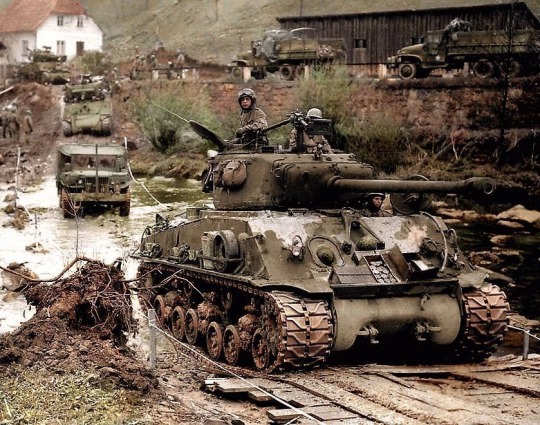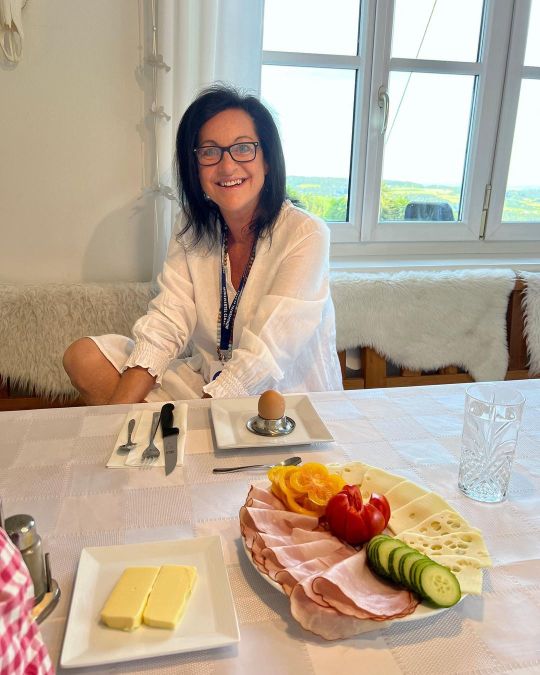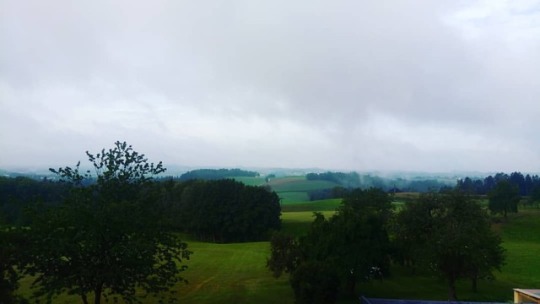#Neufelden Austria
Text

Elements of Combat Command A, 11th Armored Division crossing a portion of the Muhl River, Neufelden, Austria on May 4, 1945.
#m4 sherman#tanks#american armor#american tanks#wwii#western allied invasion of austria#western front#may
87 notes
·
View notes
Text

11th Armored Division M4A3E8 Sherman crosses the river Muhl Neufelden (Austria) on May 3, 1945, Following behind him is a M4A3E2 Sherman Jumbo arrives.
2 notes
·
View notes
Photo

Guten Morgen ihr Lieben ❤️ Wir sitzen schon wieder beim Frühstück, stärken uns für unsere heutige Tour, die in den Linzer Zentralraum führt ☝️ Vom Mühlviertler Hochland beginnend durchs obere Mühlviertel - Neufelden - - Eferding – Kirchberg – Pasching - Leonding – Freinberg – Schloss Museum Linz – Linzer Altstadt – Linzer Hauptplatz – Nibelungenbrücke – zurück zum Start. Die genauen Zuschauer - Zeiten (wann - wo - sind ja noch viel mehr) hab‘ ich euch wieder angehängt! Die Sonne scheint schon früh morgens, sieht wieder nach einem wunderbaren Tag aus! See you there … 😉 #mühlviertlerclassic #MVclassic #mühlviertlerclassic2022 #mühlviertlerclassic #privatetasteontour @muehlviertelclassic (hier: Sankt Stefan Am Walde, Oberosterreich, Austria) https://www.instagram.com/p/Ce72rIED1dP/?igshid=NGJjMDIxMWI=
0 notes
Text
Michael Pisaro — Nature Denatured and Found Again (Gravity Wave)

Nature Denatured and Found Again by Michael Pisaro
Let’s start small; Nature Denatured and Found Again is a document of five summers well spent. In the summer of 2011 Michael Pisaro, an American composer, educator, and musician associated with the Wandelweiser composers collective, traveled to Neufelden, Austria to join artist Joachim Eckl at a former storehouse called Die Station (The Station). It is situated near the Grosse Mühl, a small river that empties into the Danube. Decorated with items culled from movie sets and an old Hilton hotel, it houses some of Eckl’s work and provides living and studio space for visiting artists, who mix with each other and townspeople in encounters intended to realize Joseph Beuys’ concept of “social sculpture” (in a nutshell, the idea that people gathering together can collectively change society through art).
Pisaro first came with the intention to participate in a two-year project during which people would congregate for soundwalks up and downstream from The Station. In addition to taking in the sounds of the river and surrounding forest, participants would stop at shelters and listen to musicians perform 12-minute concerts, some of which featured music that had been composed at The Station. Afterwards the participants would listen to field recordings made during the soundwalks, and then return for another day of walks and sounds, including new ones generated by Pisaro, with these memories in mind. Talk about your antidotes to the hectic pace and distraction of post-internet and cell phone life!
Initially things went well, but then they got complicated. The first two years yielded such profound experiences that Eckl invited Pisaro and others to continue the project, but this was easier said than done. In 2013, a scaled-down version involving walks and field recordings, but no performers or listening shelters, took place. There was no gathering in 2014, and the following year Pisaro, Eckl and a few others did the final walk in a single day. Another year passed before Pisaro finally sat down to deal with the collected material. Art is shaped by the events around it, and Pisaro set to work on Nature Denatured and Found Again on the cusp of Donald Trump’s ascension. Imagine immersing yourself in the work of people bent upon bolstering humanity’s respect for nature when your own president seeks to empower the obtuse but well-financed forces of climate change denial. Since Pisaro lives in California, the time that he worked on this project coincided with the scourge of wildfires raging unchecked in neighborhoods near his own. When an artist’s extraordinary personal experience occurs amidst growing ghastliness, they can either ignore the world around them or deal with it in some way. Pisaro doesn’t deliver a screed against natural destruction, but the respectful way he treats natural sounds in his work and presents them as creative material on a par with man-made sound lets you know what side he’s on.
Nature Denatured and Found Again comprises five CDs, one for every year from 2011-2015. They are broken down into four 12 minute-long tracks. If you have five playback systems on hand, you could play the discs together for a concentrated Nature Denatured experience; here’s hoping that someone somewhere puts together an installation that runs all five discs on shuffle play until all the possible combinations have run out. Pisaro assembled each disc from material relevant to a particular year, but no disc is a straightforward document of its time. Fissures in Green (2011) includes recordings of the musicians and the environment arranged so that they invite a listener to steep in the beauty of woodwinds and water and to consider the similarity between electronically filtered noise and natural sounds, but also periodically jolts you out of reverie and into the moment by intentionally fragmenting said material. Pathsplitter (Yellow Red) (2012) takes inspiration from the experience of hearing and seeing things over and over by processing them with a readymade musical form. A canon is a composition in which a complex musical piece is created by layering different instruments or singers performing the same part at different pitches. For this disc, Pisaro has fashioned one from Jürg Frey’s clarinet, his own white noise and sine tones, and collected environmental sounds.
On Landscape in Black and Grey (2013), Pisaro works exclusively with the sounds he recorded along the Grosse Mühl. Sometimes straight, sometimes edited, sometimes electronically filtered and reassembled, the environment is everything. But for White Light Under the Door (2014), the year that Pisaro didn’t make it to Austria, he works with remembered sound in a room. Specifically he uses electronic tones inspired by the 50-hertz hum of the European electrical grid, layered into sine-tone structures. Since such tones change depending on the shape of the room and the way you orient your ears to them, this is the album’s most personal communication of the box; it’s Pisaro signaling you, from his room to yours.
Hellgrün (Small New World) (2015) confronts the fact of change, and the fact that nature does not remain static while we regard it. The piece’s raw material includes recordings from the project’s earlier years played aloud in The Station’s performance space in 2015, bursts of birdsong, and the sounds of the river recorded at different times. Pisaro shapes, isolates, and recombines these sounds, and honors nature by giving the album’s last word to cicadas, birds and flowing water. This natural music invites us to consider the possibility of its absence. What if all this is gone, and people can’t hear it anymore? Or if mankind figures out too late that its demise is a likely consequence of waging war on nature, will people no longer be around to hear what the world sounds like?
Bill Meyer
#michael pisaro#nature denatured and found again#gravity wave#bill meyer#albumreview#dusted magazine#electroacoustic music#field recordings#Wandelweiser#Neufelden Austria#Grosse Mühl#Joachin Eckl#Die Station#Joseph Beuys#nature#climate change
4 notes
·
View notes
Photo

Columna de Blindados Sherman y vehículos estadounidenses de la "11th Division Blindada" (Armored division). Vadean un río cerca de Neufelden Austria 1945. Después de la derrota del ejército francés en 1940 contra la estrategia de “guerra relámpago” del ejército alemán, los Estados Unidos notaron la importancia de las unidades blindadas en el campo de batalla. Es por eso que a los ingenieros militares estadounidenses se les ordena desarrollar inmediatamente un tanque para la Segunda Guerra Mundial. Luego, fuera de las fábricas de armas, el tanque M3 General Grant. Pero frente a las unidades enemigas, el M3 parece obsoleto. Por lo tanto, un nuevo tanque fue diseñado y producido por los estadounidenses ya en 1942, llamado M4 Sherman. No solo es utilizado por las fuerzas estadounidenses, sino también por fuerzas libres británicas, canadienses y francesas. Las diferentes versiones del tanque Sherman están diseñadas en base al chasis original y permiten a los estadounidenses tener una amplia gama de vehículos blindados adaptados a diversas situaciones y misiones. El M4 se transforma luego en un tanque bulldozer, tanque anfibio (unidad dúplex), tanque de reparación, tanque anti-mina y muchas otras variantes. Pero el tanque Sherman no es, con mucho, el mejor tanque de la Segunda Guerra Mundial. Solo tiene una potencia de fuego débil y una armadura ligera contra los tanques de tigres alemanes. De hecho, se necesitaron en promedio 5 tanques Sherman para superar un tanque alemán Tiger. https://www.instagram.com/p/CCumTtZgqff/?igshid=1grznypmfx3j0
0 notes
Photo

Alta Austria, risveglio sul Danubio. #neufelden #austria🇦🇹 #15gradi #si vedelaboemia #johannstrauss #danubioblu https://www.instagram.com/p/BmcyHhjBHLU/?utm_source=ig_tumblr_share&igshid=s0gowlqrp82i
0 notes
Text
هُوِيَّةُ (huia)
Thursday 12th December 2019
10am-12pm and 1pm-3pm
Daphne Oram Creative Arts Building, Canterbury Christ Church University.
A collaborative installation by Canterbury Christ Church University PhD students Sophie Stone (Music) and Nour Elhouda Souleh (Applied Linguistics) that investigates the sounds of spoken modern Arabic and constructions of Othering.
This installation is part of a larger project, which involves Sophie’s setting of five poems by Nour, and explores sound, silence and extended durations.
Nour's performance is taken from the idea of Marina Abramović's work "The Artist Is Present". The audience is invited to sit in front of Nour during this installation for any period of time; listening to the sounds and sharing eye-contact only.
A book is provided to leave your thoughts, associations and feelings of the work. Nour hopes to explore the Other’s perceptions of her by doing this work and add to the richness of her own embodiment experiences.
Nour Elhouda Souleh is a PhD student in Applied Linguistics at Canterbury Christ Church University. She is exploring the different constructions of the concept of Othering through lived experiences. She is particularly interested in creative and feminist research methodologies and postcolonial theory.
Sophie Stone is a composer of experimental music and PhD student at CCCU studying with Dr Lauren Redhead (Goldsmiths, University of London). Her interests include longform music, graphic and extended notation, modes of listening and silence. Sophie’s work has been presented across the UK and in Austria, such as at Sound Thought (Glasgow), Wintersound (Canterbury) and Wandelweiser’s Composers Meet Composers (Neufelden, Austria). Recent publications include ‘Pattern, Form and Silence in Amalgamations, an Extended Duration Work’ (2019) and a co-authored article by Sophie, Dr Steve Gisby, Dr Alistair Zaldua and Dr Lauren Redhead on ‘Performing Temporal Processes’ (2018) in New Sound International Journal of Music.
#canterbury#installation#arabic#othering#phd#phdstudent#cccu#music#soundart#language#daphneoram#Canterbury christ church university
0 notes